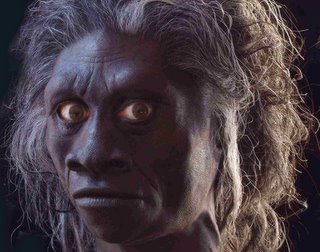

The discovery of what seemed to be dwarf hominid ["Hobbit"] fossils on the Island of Flores in Indonesia has sparked a long-running international dispute as to just what they represent.
The first, and most sensational interpretation, hilighted by National Geographic, was that the fossils represented a previously unknown hominid species -- a dwarf form of Homo Erectus -- that had persisted down to about 12,000 years ago and shared the island with Homo Sapiens. An alternative explanation was that they represented an isolated population of microcephalic homo sapiens. Then anatomical studies suggested that they represented a new australopithecine species. Complicating the picture was the presence on the island of small-statured Homo Sapiens and there was a question as to whether tools associated with the fossils had been produced by them or by modern humans.
See here, here, here, here, here, and here.
Now comes the suggestion that the "Hobbits" weren't even bipedal. A Dutch anthropologist, Gert Van den Bergh, argues that they were quadrupedal and unrelated to any known human species.
Carl Zimmer discusses the article and includes dismissive comments on it from other anthropologists here.Van den Bergh makes his case based on the long, strangely shaped arm bones of Homo floresiensis, which were recently described in the journal Nature. “The humerus of Homo sapiens (modern man) and Homo erectus (our ancestor) has a significant twist in the connection to the shoulder," van den Bergh said in a statement issued from the magazine. "In the Hobbit, however, the humerus is connected to the shoulder without twist. You don’t see this in the even more ancient Australopithecus, nor in erectus or sapiens, nor in apes, but you do see it in gibbons and macaques! As a consequence, the Hobbit’s shoulder is less mobile. Probably she could freely move her arms forward and backward, but had difficulty moving them sideways, like we can.”
Van den Bergh speculates the Homo floresiensis might have adapted to climbing steep mountain slopes as well as trees, like macaques do. “This could be an adaptation to the inhospitable and rugged island of Flores, where the largest coastal plain is just fifteen kilometers wide. The larger part of the island consists of very steep mountain sides.”
No comments:
Post a Comment